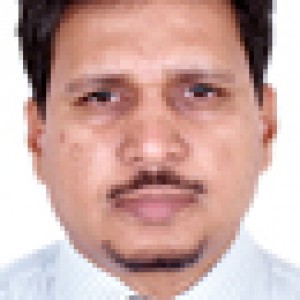Spotlight on Leaders and Trends
Interviews
- Bradley Alder
- Ali Saeed Bin Harmal Al Dhaheri
- Sergey Alexeev
- Sandy Angus
- Albert Aoun
- Marcus Bergstrom
- Stephen Brooks
- Stanley Chu
- Juan Pablo De Vera
- Michael Duck
- Simon Foster
- Renaud Hamaide
- Glenn Hansen
- Peter Neven
- Armando Arruda Pereira de Campos Mello
- Joseph V. Popolo
- Ravinder Sethi
- Lew Shomer
- Dan Spigner
- Amer N. Tabbah
- Yoshichika Terasawa
- Krister Ungerboeck
- Anbu Varathan
- Paul Woodward

Anbu Varathan
Interview by Barry Siskind on 19 May 2013
Anbu Varathan is a Metallurgical Engineer. He is a husband and father and an avid reader. In his business life he is the Chief Executive Officer of Bangalore International Exhibition Centre and the Director General of the Indian Machine Tool Manufacturers’ Association. India has experienced remarkable growth during the past decade and is one of the nations pegged to lead the world’s economy in the next decade. So, to understand the opportunities and challenges for the exhibition business in India, there is no one more qualified to ask.
Barry: You wear two hats: one as the CEO of Bangalore International Exhibition Centre and the other as the Director General of the Indian Machine Tool Manufacturers’ Association. How do you balance both roles?
Anbu: These are two hats of the same organization. The Bangalore International Exhibition Centre (BIEC) has been developed by the Indian Machine Tool Manufacturers’ Association (IMTMA) as a high quality infrastructure for industrial exhibitions. Special care is taken so that both entities get adequate time and the required priority. While both BIEC and IMTMA deploy separate teams to focus on their activities, cross-functional teams come in to play for specific activities.
Barry: Does one role ever conflict with the other? If so, how do you handle conflicts?
Anbu: There is a good level of synergy in both roles. BIEC was born out of a great need of IMTMA. While BIEC fulfils IMTMA’s demand for a high quality venue, IMTMA is also an important customer for BIEC for its success. Our stakeholders have a clear understanding of both roles and constant communication with stakeholders is a must to avoid any area of conflict. At the Board level we have a shared vision and common thinking which makes it possible to eliminate or minimize conflict.
Barry: What came first, BIEC or IMTMA?
Anbu: IMTMA, launched in 1946, is a 67 year old institution which has been organising machine tool fairs (IMTEX series) for more than 4 decades.
BIEC, launched in 2007, is seven years old. BIEC was created as IMTMA and its membership always felt the need for an international quality venue for their own machine tool show – IMTEX.
Barry: Your academic background is in Metallurgical Engineering. What motivated you to switch to running a large facility and association?
Anbu: While I started my career in the steel industry, I quickly became involved in the Association. The industry associations’ role is that of a ‘catalyst’ in making changes happen and enhancing competitiveness which I find exciting and challenging. I joined IMTMA first and a few years later IMTMA.
Barry: Let’s talk about BIEC first. How long have you been involved with the facility?
Anbu: As the Executive Director of IMTMA, I have been involved in BIEC since the pre-launch period. My role became much more involved after 2008 when I took over an additional responsibility as CEO of BIEC.
Barry: BIEC has been awarded a LEED certification. In fact you were India’s first LEED certified building. How does being a LEED certified building impact the business?
Anbu: Following the launch of BIEC in 2007, in 2008 we achieved the LEED certification in the new construction category from the US Green Building Council. LEED certification gives BIEC a unique position as a venue. It demonstrates many of our green aspects such as the usage of waste material in construction, maintaining the topography of the land, waste and rain water management, efficient energy management, non-CFC air-conditioning and maintaining 30% of the land under green cover. All the tradeshows at this venue and their participants benefit from this initiative.
Barry: How difficult was the approval process?
Anbu: To adopt and integrate LEED standards and score the required points for certification is challenging but not impossible. The approval process is fairly streamlined.
Barry: What advice would you give to other facilities who are considering obtaining LEED certification?
Anbu: I would certainly encourage other facilities to go for LEED certification and to also encourage others to follow. However, one has to be pragmatic in adopting these measures and avoid any actions that may require an exorbitant investment or may impact business prospects negatively.
Barry: What advice would you give to facilities who are not seriously considering LEED?
Anbu: Facilities are free to choose their own business principles. Perhaps, LEED is not the only way to support or demonstrate sustainability. For those facilities that are committed to promoting and demonstrating their “sustainability commitment”, the LEED certificate is essential.
Barry: You have entered into a partnership with Deutsche Messe to promote your facility worldwide. Why did you choose Deutsche Messe as your marketing partner?
Anbu: We have been in partnership with Deutsche Messe for three years. In 2007 BIEC was a brand new infrastructure in India and its international quality promised a new approach as a venue. Deutsche Messe is certainly one of the top venues for fair organisers in the world and has significant business interest in India. In addition BIEC and Deutsche Messe had both supplementary and complementary business interests. It has been a win-win partnership.
Barry: What are some of the pros and con’s of this type of partnership?
Anbu: In today’s international business arena, partnerships play a strategic role. Organisations can leverage each other’s strength as well as save time, energy and cost. The most important point is to choose partners who have synergetic business interests to ensure that the expectations of both partners are met on a continuous basis.
Barry: What is the biggest challenge BIEC faces today?
Anbu: BIEC needs to add more capacity quickly in order to meet the growth demands of larger shows. This will require additional land to build additional capacity.
Another challenge is in terms of perception. Many exhibition companies operating in India continue to have the perception that Delhi and Bombay are the most suitable cities for an exhibition.
Barry: How are you handling this challenge?
Anbu: We have plans to increase the venue capacity by 50% in the near future. We are working closely with the State Government and authorities on this.
We have also invested considerable time and effort to work with several of the key exhibition organisations and associations to change their perception of Bangalore so it is recognized as a great exhibition and event city of international quality. It is important and encouraging to see significant success happening now, as a result.
Barry: What is the future of face to face events in the next five to ten years in India?
Anbu: Face to face events, especially industrial trade shows will only grow bigger and bigger in India in the next 10 years.. The industry is at a nascent stage and has tremendous potential to grow in line with the size and growth of the Indian economy. While internet and social media will have an enabling role to play, they may not pose direct business challenges, especially where face to face interactions are crucial for business and trade decisions.
Barry: What industries will give BIEC the most significant opportunities for growth?
Anbu: While the growth and opportunities will come from a wide range of sectors, BIEC has positioned itself as the best venue in the country for manufacturing technology, industrial equipment and engineering segments. This covers machine tools, electrical equipment, air conditioning equipment, construction machinery, mining equipment, wood working machinery etc. Business opportunities from these segments will continue to grow. However, we also see significant growth opportunities in the future from Healthcare, Agriculture, Food processing and Lifestyle products.
Barry: What advise would you give an organizer who is interested in doing business in India?
Anbu: Any new player or new initiative should have a long term strategy and plan. But most importantly they should select partners and the venue based on their competitiveness and quality.
Barry: How difficult has it been to find highly qualified and motivated people to staff your facility?
Anbu: In general, qualified manpower is one of the key strengths of India.
In BIEC, while we have outsourced partners to manage the technical and essential areas such as power, water, maintenance, horticulture, IT, security, and housekeeping etc., our core team takes care of the overall management, marketing, brand promotion and customer relationships. We also invest a significant amount of time and effort in the areas of HR development and training and as a result, BIEC personnel have high standard in quality and motivation.
Barry: BIEC is a member of both UFI and IAEE. What role do you think industry associations should play in the future?
Anbu: Industry Associations like UFI, IAEE & AFECA have a tremendous role to play as a ‘catalyst’ or ‘change agent’ to the industry. While they always provide great platforms for networking, they have an opportunity to strengthen their focus and reach in the areas of training, HR development, research and supply chain. Professional associations also have a great opportunity to enable development of standards and codes of ethics for various segments of the exhibitions and events industry.
Barry: What has been the greatest benefit from your membership in these organizations?
Anbu: The conferences, congresses and various other activities offer a great opportunity for networking among industry leaders and professionals as well as the opportunity to learn best practices, technology etc. These events also enable BIEC to have a good level of visibility.
Barry: Your other hat is as the Director General of IMTMA. BIEC is owned by the Association (IMTMA). Did IMTMA originate BIEC or acquire it?
Anbu: BIEC is owned by the Indian Machine Tool Manufacturers’ Association (IMTMA). BIEC has been built and established by IMTMA as a brand new green industrial exhibition venue of international quality.
Barry: What motivated IMTMA to also include an industrial exhibition venue under its umbrella?
Anbu: IMTMA has been organising the Machine Tool Exhibition – IMTEX – for more than four decades. From 1969 until 1989 it was organised in Bombay and from 1992 to 2001 it was in Delhi. During these years, IMTMA always had a vision to hold it’s sought after machine tool show in a high quality venue which takes care of all the requirements of exhibitors and visitors. The association was also fortunate to have visionary leaders among its membership and past presidents who could not only give shape to this dream but also could commit time and support to transform the dream into an achievement. Today, BIEC is an example of how an association can achieve significant success.
Barry: I read that your association visited several counterparts in overseas countries looking for joint opportunities. What was the result of these initiatives?
Anbu: The Association (IMTMA) networks with all key machine tool associations from overseas countries and exchanges information and enhances trade relationships. The Association’s activities include trade and technology delegations to several international markets such as Germany, Turkey, USA, China, Korea, Japan, Taiwan, etc. and has participated as part of a group in machine tool shows in those markets. Such initiatives have led to improved trade and relations at an industry level.
Barry: What other major initiatives does IMTMA have scheduled?
Anbu: Broadly speaking, IMTMA has four verticals.
Under the first vertical, IMTMA focuses on policy, developmental work with Government, Data and Research, and inward / outward missions, etc.
In the second vertical, IMTMA focuses on training and organises more than 125 training programmes a year catering to machine tools and manufacturing segments.
Under the third vertical, IMTMA organises 2 Trade Fairs – IMTEX, and Forming and Modern Machine Shop (MMS). IMTEX exhibitions are one of the top shows in India with UFI certification.
The fourth vertical is about BIEC. This takes care of the management of BIEC including marketing, brand promotion and facility management.
In addition, IMTMA is currently involved in promoting a 500 acre Machine Tool Industry Park near Bangalore to encourage investment in capacity for the Machine Tool Industry and its supply chain.
Barry: Where do you see the greatest opportunities globally for growth in the Machine Tool industry?
Anbu: Global consumption of machine tools in 2012-13 was 93 Billion USD. China, of course, is the largest market. Other fast growing markets include India, Thailand, Vietnam and Korea. Emerging markets in other parts of the world such as Brazil, Turkey, and Russia in addition to mature markets like USA & EU especially countries like Germany & Italy also offer great opportunities. However, India is currently the 6th largest market in the world in terms of consumption and it will move to 5th position with consumption around 6 Billion USD by 2020.
Barry: What would organizers and facilities in the rest of the world find most surprising about India and its opportunities for business?
Anbu: The perception is that India does not have adequate venue capacity to match the size of the economy, but we now have many modern venues including BIEC which is the largest ‘Green’ facility in the country.
The maturity of trade show activities vary from sector to sector. While some of the sectors have decades of experience and strong growth, by and large it is a nascent and price sensitive market in several sectors. So, when a trade show which has been successful elsewhere in a mature market is brought to India, the success is not automatic. The organizer has to make sure that the delivery mechanism is adapted to the Indian market. This includes the right entry strategy, an in-depth plan and preparatory work, the right kind of service partners and a good proactive venue.
Barry: What is your hope for India’s business in the near future?
Anbu: India should get back to 8% – 9% of GDP growth soon. The present slowdown is temporary and reflects the situation in the world market. Given the large domestic market for goods and services in India, growth rates can be expected to return to this level in the near future.
When we look at GDP, on the PPP (Purchasing Power Parity) basis, India is currently 3rd in the world next only to USA and China. India is expected to move to second position next to China soon after 2030.
During the next decade, we will see growth and investments in a variety of sectors covering Automotive, Auto components, Electrical, Power, Aerospace, Electronics, IT, Agriculture and post harvest, Food processing, Pharma, etc. This will offer fantastic opportunities for both Indian and overseas players in our Exhibition industry. We also expect to see partnerships and collaborations in a number of areas.
More importantly, not only will the size of our exhibitions grow, but also the role the industry plays will become much more important. We see increased activities in several smaller cities and industrial pockets. We will also see a variety of innovations in delivery mechanisms.

